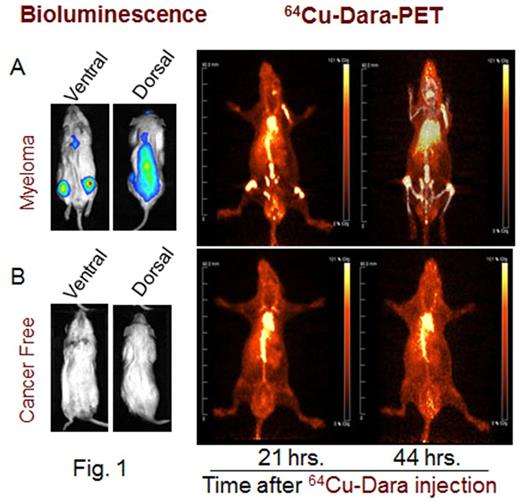Abstract
Introduction : Minimal residual disease (MRD) is known to be an independent predictor of progression free survival (PFS) in multiple myeloma (MM). Methods of MRD detection include flow cytometry, PCR based sequencing, and imaging. However, irrespective of the sensitivity of MRD detection, techniques based on bone marrow biopsies cannot account for a "patchy," non-homogenous bone marrow infiltration. Positron emission tomography (PET) coupled with computed tomography (CT) using 18fluoro-deoxyglucose as the radiotracer (18FDG-PET) is a commonly used imaging method that is much more sensitive than traditional radiographs, but it has several limitations; for one, lesions with a low metabolic rate may result in false negatives. Also, diffuse tracer uptake by normal marrow can obscure focal MM lesions. Daratumumab (Dara), a human anti-CD38 IgG1 (ĸ subclass) antibody against the highly expressed plasma cell receptor CD38, has been recently approved by the FDA for the treatment of MM. Based on the idea that Dara can selectively target MM cells irrespective of their metabolism, our group labeled Dara with the positron-emitting isotope copper-64 (64Cu-DOTA-Dara) in order to generate a novel imaging agent that can detect MM cells with high specificity. Our group already safely used 64Cu-labeled trastuzumab to detect HER2-positive tissue in breast cancer patients (Mortimer JE et. al. 2014), and here we provide the first pre-clinical evidence that 64Cu-labeled antibodies can be considered powerful imaging tools for MM detection.
Methods :Commercially availableDara was conjugated with the NHS active ester of DOTA (Macrocyclics). DOTA-conjugated antibody was incubated with 64Cu, chased with 1 mM diethylenetriamine pentaacetic acid (DTPA), and purified on a preparative size-exclusion column. The immunoreactivity of 64Cu-DOTA-Dara was also performed using purified CD38-Fc (Chimerigen Laboratories) in an HPLC size shift assay. To assess whether 64Cu-DOTA-Dara can localize to MM cells in vivo, 5 x 106 human MM1S GFP+/Luc+ cells were injected intravenously into 6 NOD-SCID mice. At 14 days, when the bioluminescence signal in the bones of the mice were detected, mice were injected with 64Cu-DOTA-Dara (50 µCi, 10 µg), and PET imaging was performed at 21 and 44 hr after the injection (Figure 1A). Cancer free mice were used as controls (Figure 1B). 18F-FDG PET/CT scans in the same group of mice were also performed. Biodistribution studies and histological analysis were also conducted.
Results : 64Cu-DOTA labeling did not affect Dara immunoreactivity against the antigen in the HPLC size shift assay. The biodistribution studies show that 64Cu-DOTA-Dara was highly detectable in the femurs, tibias, sternum and skull, known sites of MM cell invasion, which were negative in cancer-free control mice. The radionuclide was also highly detected in the lung, liver, and spleen, relative to controls. In contrast, the majority of 64Cu-DOTA-Dara remained in the blood of the control mice. Moreover, PET images show that 64Cu-DOTA-Dara PET/CT displays a higher resolution and specificity in detecting MM cells in the bones not only compared to 18F-FDG PET/CT, but even compared to bioluminescence signals from the MM cell line. To assess the specificity of 64Cu-Dara signal compared to 18F-FDG, studies using step sections in histological analysis are in process.
Conclusions : Our data support the use of 64Cu-DOTA-Dara as a novel sensitive imaging agent to detect MM. The relatively short half life of 64Cu (12.7 hours) limits potential marrow toxicity and is sufficiently long for PET/CT imaging up to 48 hours after administration of the radionuclide. A pilot study assessing the safety and feasibility of 64Cu-DOTA-Dara imaging in human subjects is under way.
Keats: Amgen: Research Funding. Krishnan: Takeda: Speakers Bureau; Onyx: Speakers Bureau; Sutro: Consultancy; Celgene: Consultancy, Equity Ownership, Speakers Bureau; Janssen: Consultancy, Speakers Bureau.
Author notes
Asterisk with author names denotes non-ASH members.


This feature is available to Subscribers Only
Sign In or Create an Account Close Modal